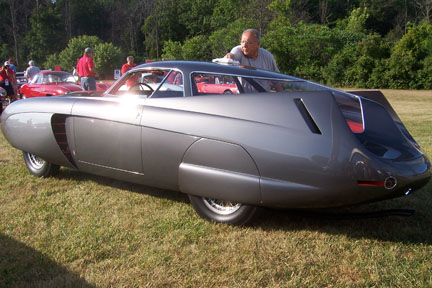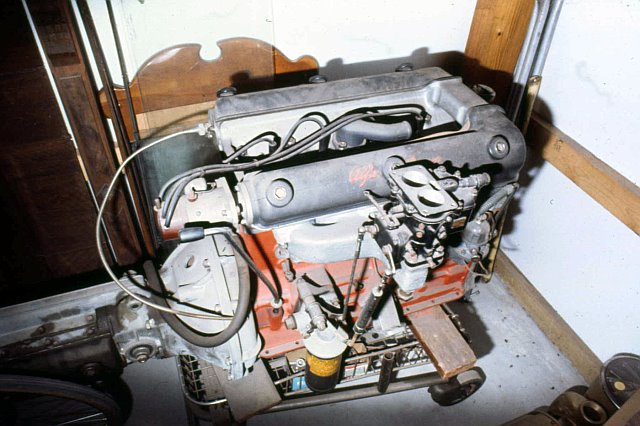
|
Home |
|
The B.A.T. coupes, of which only three were built between 1953 and 1955, are spectacular-looking vehicles which never fail to draw crowds wherever they appear. Designed by Franco Scaglione under the direction of Nuccio Bertone at Carrozzeria Bertone, all three B.A.T.s remain in existence and are currently domiciled at the Blackhawk Museum in Danville, CA. All three B.A.T.s are attractive machines, and everybody seems to have their favorite. My own favorite is B.A.T.-5, as it seems to be the purest expression of the designer's search for aerodynamic efficiency. To me, B.A.T.-7 is a bit over-wrought, and B.A.T.-9 incorporates too many compromises, as it was used to explore real production possibilities of this design direction. This article is not intended to be a history of these wonderful cars but, rather, an examination of the differences between them. The definitive history of the B.A.T.s has already been written by Jos Hugense and it appeared some years ago in Het Klaverblaadje #84, a publication of the Dutch Alf Romeo Owner's Club. The 1900 Register is endeavoring to reproduce that article for re-publication—in English—in the near future. For further information about the history of the Bertone B.A.T. cars, including B.A.T.-11, the Alfa Romeo Owners Club published a major feature in the Alfa Owner in July, 2008. (This is a large PDF file; you may prefer to download it separately and then open it outside of your browser) Please note that I'm not an expert on B.A.T.s or even on 1900s, so the opinions expressed are strictly my own. However, I must note that Sports Car Market magazine, in their January, 2021, issue featuring the trio of B.A.T.s, correctly parses the abbreviation "B.A.T." as "Berlinetta Aerodinamica Tecnica". Over the years, lazy scribes have perpetuated "Berlina Aerodinamica Tecnica", which does not make sense as these cars are coupes/berlinettas, not sedans/berlinas. |
|
|
|
|
|
|
Front view
Each of the three B.A.T.s, being aerodynamic studies by the same designer, were similar in overall shape but vastly different in detailed execution. And every aspect of the cars reflects this. For instance, all three B.A.T.s have frontal designs comprised three prominent "pontoons", if you will. Each fender is one pontoon element, and the center section is the third pontoon. This is most notable in B.A.T.s -5 and -7, while B.A.T.-9 has been toned down or smoothed-over considerably in comparison. The headlights are treated differently on each car, too. In B.A.T.-5 they open or extend inward from the sides of the pontoons, while in B.A.T.-7 they drop down from above. But in B.A.T.-9 the headlights are encased in clear covers and fixed on the points of the pontoons.
|
|
|
|

|
Rear 3/4-views
Nowhere are the differences between the three B.A.T.s more apparent than in the rear views. B.A.T.-7's wildly-exaggerated fins never fail to stop traffic! In B.A.T.s -5 and -7, you can slits that are cut into the fins. There are ostensibly to improve the rearward view of the driver, but I find that hard to believe, from looking at the photos. I've never driven or even sat in those cars, so maybe this is true. But I suspect that the real purpose of those slits is aerodynamic in some way, perhaps as boundary layer control. Whatever the case, there's no doubt that the fins created huge blind spots for the driver, a situation somewhat ameliorated by B.A.T.-9's smaller and lower fins. Perhaps to restore directional stability lost by its cut-down fins, B.A.T.-9 is the only one of these cars that incorporates a horizontal fin-type element. it's also apparent that all three cars must suffer from rather large turning diameters, as the front wheels on each are fully enclosed, with B.A.T.-9 perhaps having the most free space inside the pontoon. B.A.T.-9 also appears to be the only one of this series where some thought was given to the need for attaching a number plate on the vehicle. Whereas both B.A.T.-5 and -7 have massive ductwork behind the front wheels for relieving underhood air pressure and/or improving brake cooling, B.A.T.-9 lacks these external ducts.
|
|
|
|
|
|
Interiors
As with everything else, B.A.T.-7 has
the most extreme interior, too. |
|
|
|

|
Engines
Both B.A.T.-7 and B.A.T.-9 were built on the 1900C Super Sprint "chassis", as evidenced by their similar dual-carburetor engines. B.A.T.-5, however, was built on the older 1900C Sprint "chassis" and, as such, used the less-powerful single-carburetor engine.
|
|
Copyright © 2008-2010 Alfa Romeo 1900 Register |
|